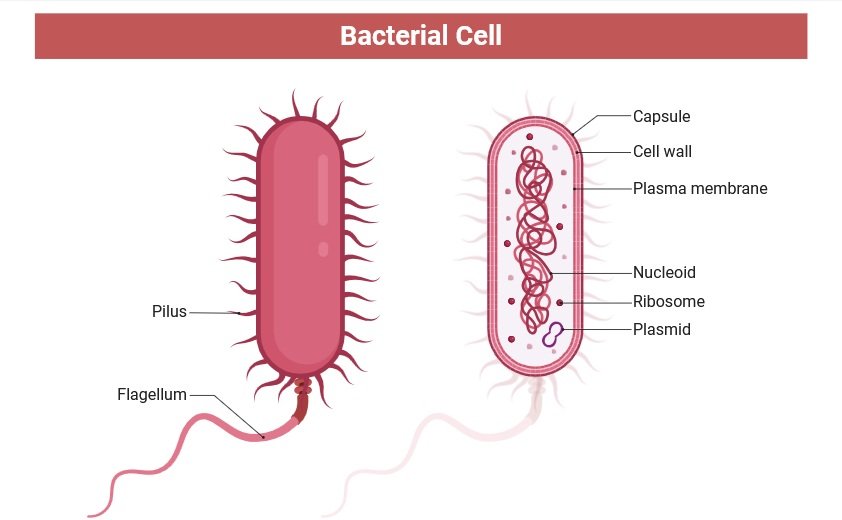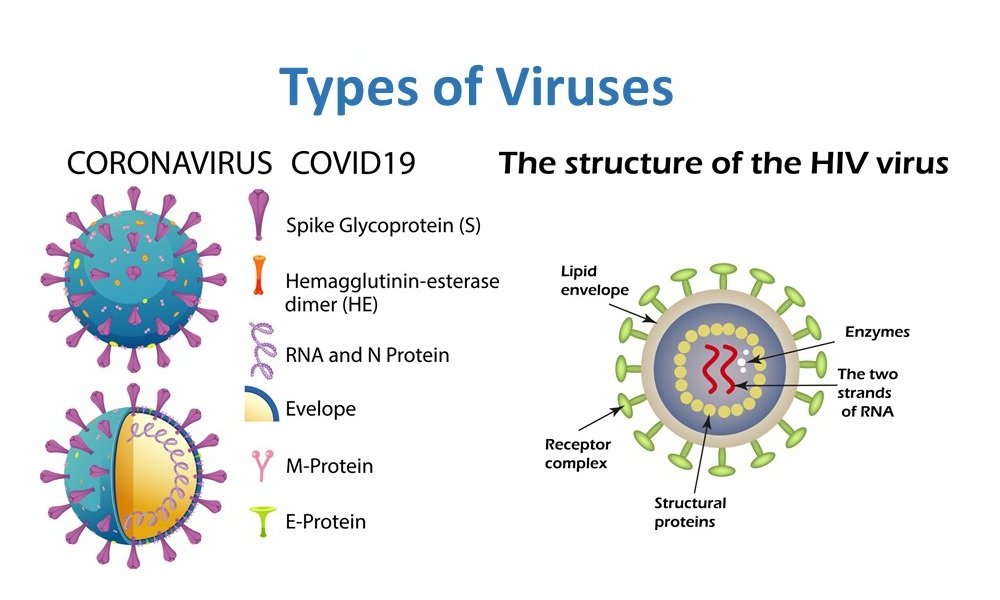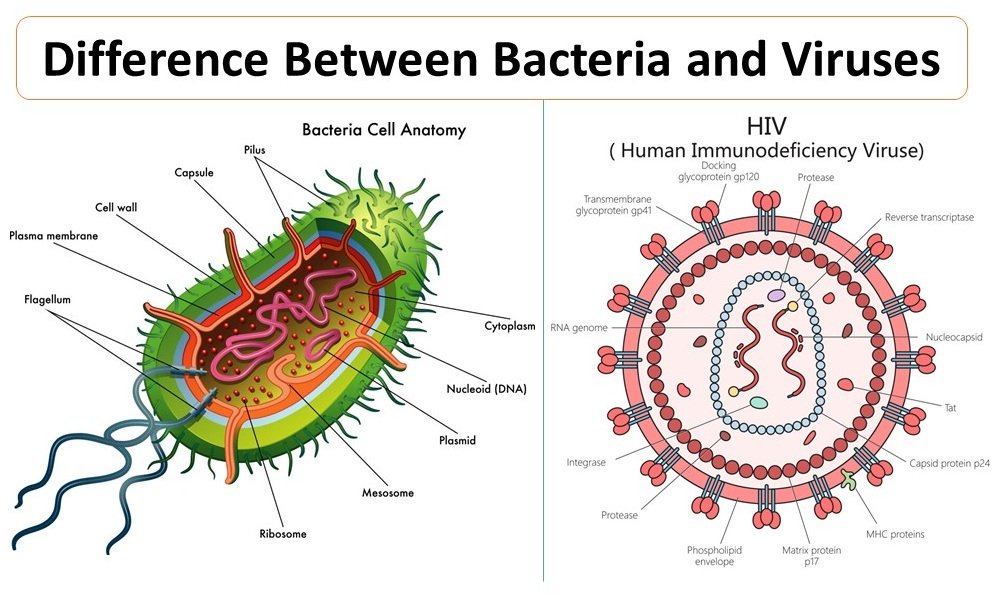Table of Contents
ToggleIntroduction
This article explains the key difference between bacteria and viruses — covering their definition, structure, metabolism, reproduction, diseases, and beneficial roles — with an easy-to-read comparison table, FAQs, and conclusion.
Microorganisms are found everywhere — in air, water, soil, and even inside the human body. Among them, bacteria and viruses are the most well-known due to their roles in health, disease, and biotechnology.
Although both are microscopic and can cause infections, they differ fundamentally in structure, life processes, and mode of reproduction. Understanding these differences is vital for diagnosing diseases, developing treatments, and preventing infections.
What Are Bacteria?
Bacteria are single-celled living microorganisms capable of performing all vital life functions — metabolism, growth, reproduction, and adaptation. They are classified as prokaryotes, meaning they lack a true nucleus and membrane-bound organelles.
Bacteria exist in nearly every environment: soil, water, air, extreme temperatures, acidic or alkaline habitats, and within living organisms. They reproduce mainly by binary fission, a process where one cell divides into two identical cells.

Key Features of Bacteria:
- Have both DNA and RNA.
- Possess a cell wall, cytoplasm, and cell membrane.
- Some have flagella (for movement) or pili (for attachment).
- Exhibit diverse shapes — cocci (spherical), bacilli (rod-shaped), and spirilla (spiral).
- Can be beneficial (e.g., gut bacteria, nitrogen fixers) or pathogenic (e.g., Mycobacterium tuberculosis).
What Are Viruses?
Viruses are non-living infectious agents much smaller than bacteria. They contain either DNA or RNA (never both) enclosed in a protein coat (capsid), and sometimes a lipid envelope.
Unlike bacteria, viruses lack metabolism and cellular machinery. They cannot grow or reproduce independently — instead, they must invade a host cell and use its machinery to replicate. Because of this dependency, viruses are often described as being “on the edge of life.”

Key Features of Viruses:
- Acellular (no cytoplasm or organelles).
- Composed of nucleic acid + protein coat.
- Obligate intracellular parasites — require a living host.
- Replicate through lytic or lysogenic cycles.
- Cause diseases like COVID-19, influenza, HIV/AIDS, and measles.
Comparison Table: Bacteria vs. Viruses
| Feature | Bacteria | Viruses |
| Definition | Single-celled living microorganisms capable of independent life and reproduction. | Non-living infectious agents consisting of genetic material (DNA or RNA) enclosed in a protein coat; require a host for replication. |
| Cellular Structure | True cells with cytoplasm, cell membrane, and usually a rigid cell wall; may have flagella, pili, or capsules. | No cellular structure; composed of nucleic acid (DNA or RNA) inside a protein coat (capsid); some have a lipid envelope. |
| Genetic Material | Contains both DNA and RNA; DNA is usually circular; plasmids may be present. | Contains either DNA or RNA (not both); genome can be single- or double-stranded, linear or circular. |
| Metabolism | Has metabolic machinery; can generate energy, synthesize proteins, and replicate independently. | Lacks metabolic machinery; cannot produce energy or proteins; relies entirely on host cells. |
| Reproduction | Reproduce asexually through binary fission; some exchange genetic material via conjugation, transformation, or transduction. | Replicate only inside a host cell by hijacking its machinery; replication cycles include lytic and lysogenic pathways. |
| Size | Relatively large; typically, 0.5–5 micrometres. | Much smaller; generally, 20–300 nanometres, requiring electron microscopy for visualization. |
| Living Conditions | Can survive in diverse environments, including soil, water, extreme temperatures, and inside hosts. | Can survive outside a host only briefly; require host cells to multiply and propagate. |
| Diseases Caused | Tuberculosis, cholera, strep throat, urinary tract infections, food poisoning, and more. | Influenza, COVID-19, measles, HIV/AIDS, hepatitis, chickenpox, and more. |
| Treatment | Usually treatable with antibiotics; some infections require specific antibacterial therapies. | Antibiotics are ineffective; treated with antivirals, vaccines, or supportive care. |
| Beneficial Roles | Aid in digestion, vitamin synthesis, nitrogen fixation, bioremediation, and fermentation. | Bacteriophages can target harmful bacteria; used in research and therapeutic applications. |
| Immune Response | Can be recognized by the immune system; immune memory often develops after infection. | Trigger immune response; vaccination is often required to prevent infection. |
| Replication Speed | Rapid; some can divide every 20 minutes under optimal conditions. | Dependent on host; replication speed varies with host cell type and virus strain. |
| Mutation Rate | Moderate; DNA-based bacteria mutate slower; horizontal gene transfer can accelerate evolution. | High; RNA viruses mutate quickly due to lack of proofreading during replication, leading to rapid evolution. |

Key Differences Summarized
- Living Status: Bacteria are fully living cells; viruses are non-living until inside a host.
- Structure: Bacteria have cellular organization; viruses are just genetic material with a protein coat.
- Reproduction: Bacteria divide independently; viruses require host machinery.
- Treatment: Antibiotics work on bacteria, not viruses.
- Beneficial Role: Many bacteria are useful; viruses are mostly harmful except in research and biotechnology.
Medical Importance
- Bacterial Infections are treated using antibiotics such as penicillin or tetracycline. However, misuse can cause antibiotic resistance.
- Viral Infections require antivirals (e.g., remdesivir, acyclovir) or are prevented by vaccines such as those for COVID-19 or polio.
- Laboratory diagnosis uses culture techniques for bacteria and molecular methods (PCR, ELISA) for viruses.
Beneficial Applications
| Microorganism Type | Applications |
| Bacteria | Used in food production (yogurt, cheese), biotechnology (gene cloning), waste treatment, and agriculture (biofertilizers). |
| Viruses | Bacteriophages are used in phage therapy to kill drug-resistant bacteria; viral vectors are essential in vaccine development and gene therapy. |
Conclusion
While both bacteria and viruses are microscopic agents that affect human health, their fundamental biology is distinct.
- Bacteria are living cells capable of independent survival and reproduction, many of which are beneficial to humans and ecosystems.
- Viruses, on the other hand, are non-living parasites that depend entirely on host cells for replication.
Understanding these differences is essential for proper diagnosis, treatment, and prevention of infections — and for appreciating how these tiny entities shape life on Earth.
Frequently Asked Questions (FAQs)
Q1. Are viruses living or non-living?
Viruses are considered non-living because they lack cellular structure and metabolism. They only show life-like properties when inside a host cell.
Q2. Can antibiotics kill viruses?
No. Antibiotics target bacterial metabolism and cell walls, which viruses lack. Viral infections are managed with antivirals or vaccines.
Q3. Why are viruses smaller than bacteria?
Viruses consist only of genetic material and a protein coat, while bacteria have complex cell structures. Hence, viruses are 10–100 times smaller.
Q4. What is the main difference between bacterial and viral reproduction?
Bacteria reproduce independently by binary fission, while viruses replicate only inside host cells using their machinery.
Q5. Can bacteria and viruses both be beneficial?
Yes. Many bacteria are beneficial (e.g., Lactobacillus in the gut), and viruses like bacteriophages are useful in gene therapy and phage therapy.
Also Read
- Difference Between Probiotics and Prebiotics
- Microbiology Interview Questions and Answers for Freshers
- Plasmids: Structure, Types, Replication, and Applications
- Microbiology of Fermented Foods
- Microbiology: From Microorganisms to Career Opportunities
- Culture Staining Techniques in Microbiology: Types, Methods, and Applications
- Microbiology Experiments for Students: A Complete Guide
- What is Microbiology? History, Scopes & Applications
- Importance of Microbiology: Applications, Scope, and Benefits
- Branches of Microbiology: An Overview of Key Fields
- Bacillus subtilis– Morphology, Habitat, Diseases & Industrial Applications
- Rhizobium: The Nitrogen-Fixing Bacterium
- Detection of Viruses: Modern Methods, Applications, and Advancements

